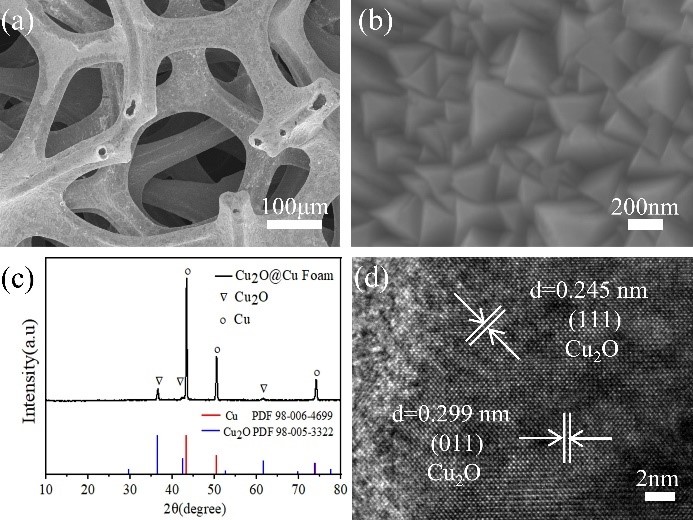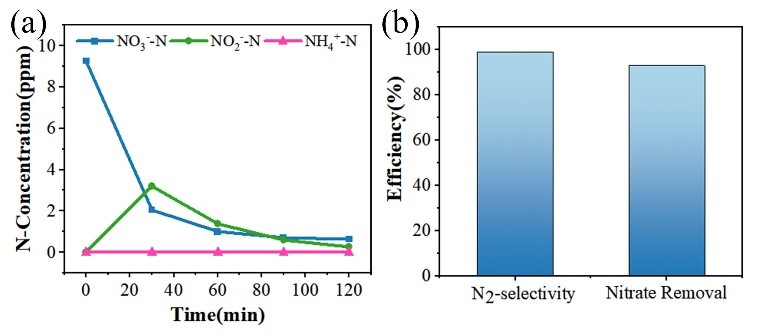
According to a paper published recently on Chemical Communications, Prof. MENG Guowen's group from the Institute of Solid State Physics, Hefei Institutes of Physical Science (HFIPS), Chinese Academy of Sciences (CAS) has made an efficient electrocatalytic material to reduce nitrate in water to nitrogen gas, providing a promising way to degrade the concentration of nitrogen in the water.
"This material is a success in improving the selectivity of electrocatalytic reduction of nitrate for N2 in water," said associate Prof. TANG Haibin, who was in charge of this study.
Nitrate, a dangerous water pollutant, is inclined to lead to water eutrophication, water bloom and other ecological and environmental problems. Among the nitrate removal methods and technologies, the electrocatalytic reduction method stands out as it can selectively convert nitrate (NO3-) into ammonium (NH4+) or nitrogen gas (N2). In particular, this method can effectively reduce the concentration of total nitrogen in water by converting nitrate to N2, showing great application prospect for restoration of eutrophicated water body. However, the reported materials, although with preferential selectivity and efficiency towards ammonia/ammonium, are not suitable for the application in practical water environment such as lakes and rivers.
In this research, scientists fabricated a Cu2O thin films with (111) preferred orientation on the surface of porous copper foam frame (Cu2O@CF) by electrochemical deposition method. The composite structure was facilely used as a cathode for electrocatalytic reduction of nitrate because of the conductive porous copper foam frame. It was found that the catalytic reduction of nitrate to N2 was significantly improved.
"In alkaline solution, the removal rate of nitrate was 93% with the selectivity for N2 of 99%; in neutral solution, the removal rate of nitrate was 94.3% with the selectivity for N2 of 49.2%", said TANG.
In order to verify the potential interference on the performances of other cations and anions contained in actual water bodies, the electrocatalytic test was carried out with the practical lake water collected from a local reservoir.
"The removal rate reached as high as 91.1% for nitrate and the selectivity for N2 rose up to 64.2%," he further explained, "both were higher than what we had expected."
The preparation of the cathode material in this research is simple, and it can realize high selectivity for nitrogen gas, showing the application potential of Cu2O in electrocatalytic reduction of nitrate to nitrogen gas.
This work provides a valuable reference for further designs of stable and efficient electrocatalytic materials for removal of nitrogen in water, contributing to the treatment and protection of water ecological environment.
The research was financially supported by the National Natural Science Foundation of China, the Natural Science Foundation of Anhui Province, and the Key Research Program of Frontier Sciences of the Chinese Academy of Sciences.

Fig. 1 (a-b) SEM images and (c) XRD pattern of the electrodeposited Cu2O thin films on frame of Cu foam; (d) HRTEM image of the as-prepared Cu2O thin films. (Image by TANG Haibin)

Fig. 2 (a) Time-dependent concentration change of NO3--N, NO2--N and NH4+-N; (b) N2-selectivity and nitrate removal efficiency under the reaction conditions: 40 mg/L NO3-, 0.05 M K2SO4, pH=11, applied potential of -1.4 V (vs. Ag/AgCl). (Image by TANG Haibin)

Fig. 3 (a) Time-dependent concentration evolution of NO3--N, NO2--N and NH4+-N; (b) the N2 selectivity and nitrate removal efficiency in spiked actual water with the reaction conditions: 40 mg/L NO3-, 0.05 M K2SO4, pH = 7, applied potential of -1.4 V (vs. Ag/AgCl). (Image by TANG Haibin)